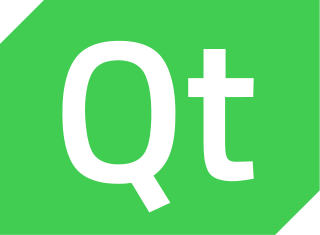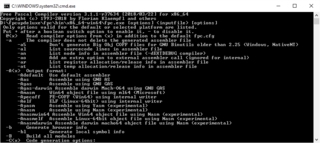Related Research Articles

Qt is a widget toolkit for creating graphical user interfaces as well as cross-platform applications that run on various software and hardware platforms such as Linux, Windows, macOS, Android or embedded systems with little or no change in the underlying codebase while still being a native application with native capabilities and speed.

Windows Notepad is a simple text editor for Windows; it creates and edits plain text documents. First released in 1983 to commercialize the computer mouse in MS-DOS, Notepad has been part of every version of Windows ever since.

FreeGEM released in 1999 is a windowing system based on Digital Research's GEM which was first released in 1985. GEM stands for "Graphics Environment Manager".
In computer programming, an application framework consists of a software framework used by software developers to implement the standard structure of application software.

wxWidgets is a widget toolkit and tools library for creating graphical user interfaces (GUIs) for cross-platform applications. wxWidgets enables a program's GUI code to compile and run on several computer platforms with minimal or no code changes. A wide choice of compilers and other tools to use with wxWidgets facilitates development of sophisticated applications. wxWidgets supports a comprehensive range of popular operating systems and graphical libraries, both proprietary and free, and is widely deployed in prominent organizations.
Delphi is a software product that uses the Delphi dialect of the Object Pascal programming language and provides an integrated development environment (IDE) for rapid application development of desktop, mobile, web, and console software, currently developed and maintained by Embarcadero Technologies.

NewWave is a discontinued object-oriented graphical desktop environment and office productivity tool for PCs running early versions of Microsoft Windows. It was developed by Hewlett-Packard and introduced commercially in 1988. It was used on the HP Vectras and other IBM compatible PCs running MS Windows.

Free Pascal Compiler (FPC) is a compiler for the closely related programming-language dialects Pascal and Object Pascal. It is free software released under the GNU General Public License, with exception clauses that allow static linking against its runtime libraries and packages for any purpose in combination with any other software license.
DataFlex is an object-oriented high-level programming language and a fourth generation visual tool 4GL for developing Windows, web and mobile software applications on one framework-based platform. It was introduced and developed by Data Access Corporation beginning in 1982.

Windows Forms (WinForms) is a free and open-source graphical (GUI) class library included as a part of Microsoft .NET, .NET Framework or Mono Framework, providing a platform to write client applications for desktop, laptop, and tablet PCs. While it is seen as a replacement for the earlier and more complex C++ based Microsoft Foundation Class Library, it does not offer a comparable paradigm and only acts as a platform for the user interface tier in a multi-tier solution.

StarTeam is a revision control system used in software development, especially when a project involves multiple teams in different locations. StarTeam is an SCM and SDLC software application, created by Starbase Corporation, which was acquired by Borland in January 2003 which was acquired by Micro Focus in July 2009. The application is client-server, backed by a relational database that retains all changes made to a project during its evolution as well as the project requirements, task assignments, threaded discussions and bug tracking. Microsoft SQL Server and Oracle database are supported database servers.
Merge is a software system which allows a user to run DOS/Windows 3.1 on SCO UNIX, in an 8086 virtual machine.
CommSuite 95 was a communications software suite of products launched by the Canadian software company Delrina in late 1995.

In computer interface design, a ribbon is a graphical control element in the form of a set of toolbars placed on several tabs. The typical structure of a ribbon includes large, tabbed toolbars, filled with graphical buttons and other graphical control elements, grouped by functionality. Such ribbons use tabs to expose different sets of controls, eliminating the need for numerous parallel toolbars. Contextual tabs are tabs that appear only when the user needs them. For instance, in a word processor, an image-related tab may appear when the user selects an image in a document, allowing the user to interact with that image.
Meeting Maker is a cross-platform personal calendar and group scheduling software application from PeopleCube. First released in 1991 for Macintosh by ON Technology, support for other platforms followed in 1993 with Meeting Maker XP. Alongside Windows and Mac, native clients were released for OS/2 and Solaris and later also for other platforms. Some support was introduced also for mobile platforms like Apple Newton, PalmPilot and Windows CE. Although powerful, its user interface - aiming at uniformity across multiple platforms - was criticized as weak and not supporting all features of target platforms.
Aldus PhotoStyler is a graphics software developed by the Taiwanese company Ulead. Released in June 1991 as the first 24 bit image editor for Windows it was bought the same year by the Aldus Prepress group. Its main competition was Adobe Photoshop. Version 2.0 introduced new user interface and improved color calibration. PhotoStyler SE - lacking some features of the version 2.0 - was bundled with scanners like HP ScanJet. The product disappeared from the Adobe product line after Adobe acquired Aldus in 1994.
Ashlar-Vellum, a dba of Ashlar Incorporated, is a developer of Computer-aided design (CAD) and 3D modeling software for both the Macintosh and Microsoft Windows platforms. Ashlar-Vellum's interface, designed in 1988 by Dr. Martin Newell and Dan Fitzpatrick, featured an automated Drafting Assistant that found useful points in the geometry and allowed the artist to quickly connect to locations like the "midpoint" or "tangent".
The Actor programming language was invented by Charles Duff of The Whitewater Group in 1988. It was an offshoot of some object-oriented extensions to the Forth language he had been working on.

Dr. Halo is a raster graphics editor developed by Media Cybernetics and released for computers running MS-DOS. It was among the first graphics editors available for MS-DOS with its initial release in 1984. Media Cybernetics boasted about three million users of Dr. Halo between 1984 and 1993.
References
- ↑ "Product Comparison, Portable GUI frameworks, Program once, port often". InfoWorld. Vol. 17 no. 6. IDG. February 6, 1995. pp. 70–72, 76–78, 80–82. ISSN 0199-6649.
- ↑ Zimmer, M. (1996). "The H1 Data-Quality Tool-GUI Programming With A Commercial C++ Class-Library". Proceedings of the International Conference on Computing in High Energy Physics '95: 644. Bibcode:1996chep.conf..642Z. doi:10.1142/9789814447188_0117. ISBN 978-981-02-2783-8.
- ↑ Watt, Peggy (May 21, 1990). "Third-Party Tools Announced at Borland's Turbo C++ Rollout". InfoWorld. Vol. 12 no. 21. IDG. p. 21. ISSN 0199-6649.
- ↑ Ayre, Rick; Ayre, Sue (December 17, 1991). "Zinc Delivers a Robust Interface Library For Windows Application Development". PC Magazine. Vol. 10 no. 21. Ziff Davis. p. 75. ISSN 0888-8507.
- ↑ Johnston, Stuart J. (August 15, 1994). "Zinc unites environments, languages with one code". Computerworld. Vol. 28 no. 33. IDG. p. 72. ISSN 0010-4841.
- ↑ "Press Release--Zinc Announces ZAF 5" (Press release). Pleasant Grove, Utah: Zinc Software. June 20, 1997. Archived from the original on February 12, 1998. Retrieved May 25, 2018.
- ↑ Coffee, Peter (September 29, 1997). "Zinc Application Framework: A too-well-kept secret". PC Week. Archived from the original on June 5, 2001. Retrieved May 25, 2018.
- ↑ Coffee, Peter (July 6, 1998). "Wind River, Zinc to duel Win CE". PC Week. Archived from the original on April 27, 1999. Retrieved May 25, 2018.
- ↑ "PSA Press Releases, Milestones Partnering, 2004". PSA. 2006. Archived from the original on December 15, 2006. Retrieved May 25, 2018.